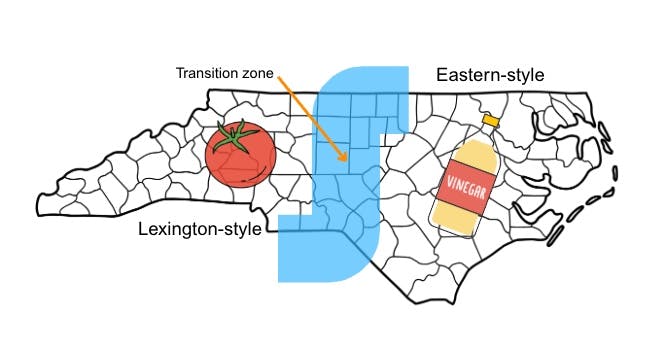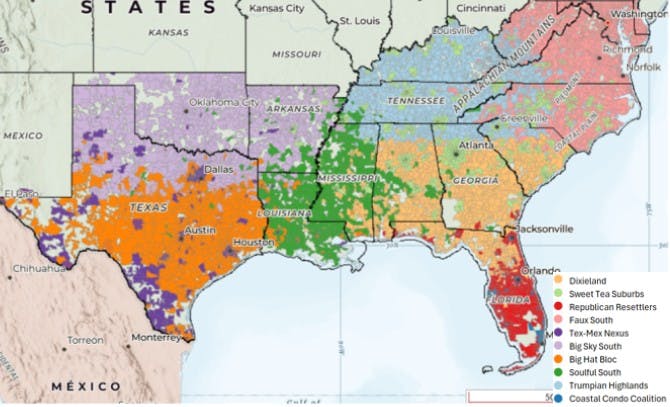Editor’s note: This is the fourth installment of a six-part series by pollster Brent Buchanan on the politics of the American South. Last week, Buchanan broke down the unique features and critical importance of the Southern suburbs. Today, he takes a close look at North Carolina.
We hope you enjoy.
It might sound like a stretch to think voting behavior and political divides in one of the South’s most consequential swing states could be explained by barbecue sauce.
But that’s exactly what we found in North Carolina.
In both barbecue sauce and politics, North Carolina’s “split personality” is rooted in centuries-old settlement patterns and evolving demographics. Barbecue here is a source of pride, and, like taste preferences nationally, voters in the Tar Heel State — or, shall we say, the Sauce State — are divided.

The so-called “barbecue boundary” is more than a culinary cleave; it reflects the state’s foundational divisions. Western North Carolina, settled predominantly by German and Moravian immigrants, developed the Lexington style of barbecue with tomato-based sauces.
Then there’s Eastern North Carolina, settled earlier by English and Scots-Irish immigrants, known for their whole-hog barbecue and vinegar-based sauces. These regional distinctions mirror broader cultural and political divides, with the western “Trumpian Highlands” standing apart from the more moderate “Faux South” and gridlocked “Sweet Tea Suburbs” of the east.

Our analysis shows a political patchwork of those Trumpian Highlands in the west reflecting the deep-red, Appalachian-rooted strongholds that have surged rightward in recent years, and the Faux South in the east, which is a concentration of moderate, Mid-Atlantic-influenced counties shaped by trade routes rather than mountain and lowland plantation culture. Mixed in are the modern Sweet Tea Suburbs, encompassing the politically gridlocked, middle-class communities ringing cities like Raleigh and Charlotte.
“The Tar Heel State’s battleground status is primarily driven by their voters in the Trumpian Highlands,” said Nicholas Valdiviez, Cygnal’s Sampling Lead, who spearheaded this project. “The turnout differentials are even more galvanizing where we saw those areas jumping 14% for Republicans from 2012 to 2016, and falling 16% for Democrats in this same time, which is a whopping 31% delta in turnout between parties leading into Trump’s first term.”
By 2024, the Republican margin in the Trumpian Highlands reached 74-26, rivaling the deepest red regions anywhere in the South. However, keep in mind this region was among the hardest hit by Hurricane Helene and while they may have been trending Republican in recent years, President Joe Biden’s woeful (putting it mildly) response could have added fuel to voters’ enthusiasm for Trump.
These numbers still suggest a partisan ceiling in the western part of the state, excluding more liberal pockets like Asheville and Charlotte, meaning the GOP’s continued dominance here will depend on sustaining enthusiasm among rural voters, especially as the state’s population centers continue to grow and attract out-of-state liberals. Without the magnetism of Trump atop the ticket, Republicans can’t bank on the lovers of Lexington BBQ to deliver a statewide win.
Meanwhile, on the eastern side of the barbecue boundary, the Faux South region — with its Mid-Atlantic heritage and more moderate political leanings — tells a different story. The region as a whole saw Republicans peak in 2016, winning 52% of the vote, but then saw the steepest decline of any southern region from 2016 to 2020, with only a mild recovery. North Carolina was a latecomer to the larger trend in 2024, showing a five-point spread favoring Republicans.
Then, from 2020 to 2024, the Faux South shifted three points to the right, signaling that even in historically challenging areas, the GOP is capable of making incremental gains and keeping them. But it is the region’s volatility that makes it a true wild card — one that could swing statewide outcomes if either party finds the highly attractive candidates, compelling messages, and a solid mobilization strategy.
As we mentioned, the Sweet Tea Suburbs surrounding North Carolina’s major cities are politically gridlocked, with little movement since 2008. Turnout and margins are often determined by local issues and demographic changes from transplant residents.
“Though Republicans don’t control the governor’s mansion, they do hold both Senate seats and a majority of House seats,” said Valdiviez. “But if both sides of the barbecue boundary, Lexington and Eastern-style, continue to grow in population — especially in the ‘burbs — things could make the politics more precarious for Republicans.”
Valdiviez is right: things could get dicey for Republicans, but only if they fail to connect with middle-class voters’ day-to-day concerns in the same way Democrats have.
But things look different if Republicans make those more moderate Democrats in North Carolina distance themselves from or defend the radical voices of Bernie Sanders and AOC, who now lift the party’s mantle. Just because the suburbs’ inelasticity is inherently left-leaning does not mean those ardent Leftists won’t alienate independent voters in the same way they did in 2024, turning North Carolina to Republicans.
North Carolina’s electoral map is a lot like its barbecue boundary: divided, fiercely proud of its local identity, and resistant to one-size-fits-all solutions. It requires a nuanced understanding of each region’s history, culture, and evolving priorities. And just like BBQ in North Carolina, if you bring the wrong sauce in the wrong region, you’re going to be asked politely to leave.

COMING UP NEXT: Like North Carolina, all eyes are on Georgia, especially as revelations about Stacey Abrams’ shady political machine during the Biden years and Republicans look to unseat the swing state’s vulnerable Democrat Senator, John Ossoff.

ABOUT THE MAP: Amid America’s massive political realignment, mostly ushered in by President Donald Trump’s MAGA movement, the South is more consequential than anywhere else. It is responsible for more than a third of Senate seats, the equivalent of an entire class of Senators up for reelection in any cycle, and it accounts for 193 electoral votes, more than half the needed amount to win a presidential election.
By breaking the South into distinct regions, we can better understand the layered realities on the ground. We named each of the South’s regions out of necessity, not novelty. This regional lens reveals patterns and divides that state lines alone obscure, allowing for a more accurate and intelligible analysis of the South’s electoral dynamics.
This large-scale project aggregates voter trends in areas like education, income, gender, age, and partisanship – and even some of our own recent polling data. So far, we’ve analyzed everything from the realignment of its minority voters, the stagnation of its suburbs, and the necessity to call out its unique regions, which transcend state lines and better define its implications on national elections.

.png)
.png)

